
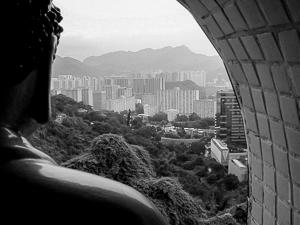
On this, my fourth trip to China, I was visiting Xi’an, China’s ancient capital city located about 600 miles southwest of Beijing. I had come to speak at the World Bioenergy Congress. The Congress brought together experts from around the world to share the latest research and development related to emerging renewable energy, including biogas development from agriculture and urban wastes that has been the focus of my work for more than a decade.
Emperor Qin Shi Huang, who unified China in 221 B.C., made Xi’an China’s capital, and it was here that the well-preserved, 6,000-year-old Neolithic village of Huangpu was uncovered. Here, at the age of 13, that Emperor Qin began building his necropolis that includes his tomb and the famed terra cotta army. It’s said that the 700,000 slaves labored a lifetime to build the necropolis and were buried alive after completing it, sealing with their lives the tombs secrets. For more than 2,000 years, it remained a secret until a farmer, hand digging a well, broke through the roof and uncovered what is now considered to be the Eighth Wonder of the World.
Today’s Xi’an is a city of some 8.5 million people – very large indeed, but ranked 10th in population compared to the 22 million who reside in Beijing, the 20 million in Shanghai and the 15 million in Chongqing. From the moment I landed around midnight at the Xi’an airport, bleary-eyed from more than 20 hours of travel, I entered a world of almost bewildering change. Although it was mostly dark along the 25-mile drive to my hotel, I could make out the faint outlines of a virtual forest of high-rises in various stages of construction. Blinking red lights in the sky marked the building heights and the cranes that helped erect them. I counted 85. Where on earth but in China will you see 85 construction cranes along one thoroughfare? Perhaps there were a thousand cranes operating in greater Xi’an. Why not?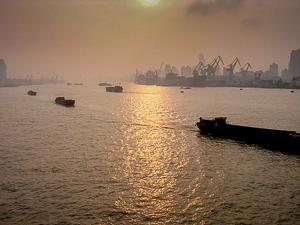
After a fitful night’s sleep, I awoke, opened the hotel curtain and gazed out on air so thick with particulate I couldn’t see more than a mile. As I learned on an outing into the countryside a few days later, and when I visited Beijing and Shanghai on my way out of China, there is a pall over all of the country, caused by the incessant burning of coal that generates more than 80 percent of China’s energy. As a result, the country always appears to me like an image out of focus.
In today’s Xi’an, you hardly see a bicycle. The streets are clogged with cars, including the sleek Audi 6, the favored car among the local elite. The major boulevard in front of the hotel was being torn up as part of the construction of an underground transportation system, part of the incessant construction that characterizes modern urban China. These underground lines might take five years or more to build in Los Angeles, but they would be finished here in only one year. Nearby, from what I could make out from my hotel window, there were a few vestiges of old brick- and clay-roofed neighborhoods, but for the most part such sights are now a memory – torn down and replaced by the ubiquitous high-rise apartments.
Growth of this magnitude – unprecedented in world history – has made China the subject of endless fascination and envy mixed with a strong dose of fear. One can’t help but be fascinated by the sweep of change, so vast, so bold and proceeding at seemingly lightning speed. China’s stunning growth rate and its ability to execute vast infrastructure projects almost at will has made American observers pine for the days when we were the world’s can-do country. Underlying this fascination and envy is a deep-seated fear that China is fast approaching the time when it may eclipse America, economically and perhaps in many other important ways. What, then, will become of us?
The Pollution Problem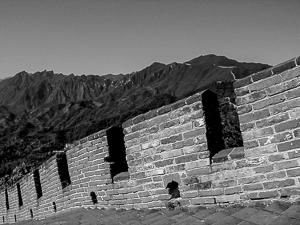
To be sure, modern China is a physical colossus, an unbridled growth machine that cannot help but inspire. Its sheer physicality – its roads, bridges, power plants, high-rise apartments, bullet trains, cultural centers – is a marvel that almost defies human comprehension. But I also found rawness, a uniformity and one-dimensionality to the country’s presence that was oppressive. And worse still was the air pollution.
This bad air reminded me a trip to China I took nearly 20 years ago with my wife as a U.S. Information Service Speaker as part of a cultural exchange program run by the State Department. On one leg of the trip, we were in the northern city of Shenyang. The person heading the consulate office there described to us how bad the air was from coal burning. She explained that an American marine who manned the consulate office, upon his return to the States, was given a physical exam and asked if he was a heavy smoker. The physician who examined him told him that he had the lungs of a three-pack-a-day smoker. But he wasn’t one.
Twenty years later, the air pollution remains, and it’s a subject of great sensitivity for the government and a grave concern for its people. During the 2008 Olympic Games in Beijing, the Chinese government basically shut down whole industries nearby to produce acceptable air quality. Within days after the Games ended, the terrible air returned. Recent news about prickly Chinese officials criticizing the U.S. Embassy for publishing Beijing’s air quality as measured by the Embassy’s air monitoring station underscores what a sore spot air pollution is in official China’s psyche. According to a recent article published in The Economist, air pollution ranks with government corruption and income disparity as one of the three most pressing concerns of the Chinese people.
Coal Dependence
Cleaning up China’s air will be no small challenge. Technically, of course, it can be done. But China’s situation makes solving its air problem especially vexing. For starters, the country is more than 80 percent dependent on coal for its energy needs. In order to prevent social unrest from a vast rural population that has migrated to its cities for work, China maintains that its GDP must grow by at least seven percent per year. In order to maintain this pace of growth, the country must continue its coal dependence well into the future.
Although China is a world leader in building a renewable energy infrastructure and an export industry, building this infrastructure and industry depends on coal. China continues to pollute its air even in the building of its renewable energy enterprises. If the country was perhaps richer and its build-out less frenetic, it could better transition to a more renewable energy base. But making a transition to renewable energy requires the presence of back-up energy capacity that can be tapped when solar or wind sources are limited. Without that back-up, blackouts and brownouts will happen, and they would threaten the seven percent minimum growth rate. The problem is further compounded by the competing vested interests that benefit from China’s growth machine – its political leadership, whose tentacles weave throughout its economic enterprises, derives perks and considerable wealth from running the very enterprises that must change.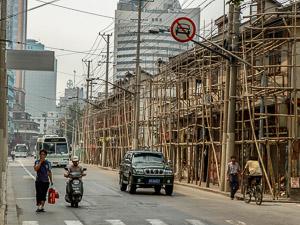
In contrast to China, making a transition away from a dependency on coal and other fossil fuels now looks to be a more attainable task for the United States than I had previously thought. Our infrastructure is mature, and although some of it is decrepit and much is in need of repair, it can be restored and upgraded at a much lower cost than building a whole new infrastructure, as is the case in China. Moreover the energy to repair the infrastructure will increasingly come from natural gas and renewable resources so the pollution impacts from repositioning the energy sector will be much less than in China.
Command and Control Governance
Another perspective on China that changed with this trip was the economic advantage that China seemed to have over the United States with its centralized command and control governance. How can American society, burdened with a decision-making system of checks and balances, an empowered citizenry, and a maze of rules and regulations, compete with a Communist-ruled technocracy that has absolute power to design, build and operate its enterprises?
I was having my doubts about our competitive prospects until I returned home to Los Angeles and took the hundred-mile drive to my home in Santa Barbara. Even hurly-burly Los Angeles seemed relatively calm and subdued in contrast to the turmoil I experienced on the streets of Xi’an. The air, though not great, was a far cry from what I breathed over there. The freeways I considered to be in such a state of breakdown were, in fact, quite good, considering California’s decimated state budget. When I woke up the following morning, I walked my dog under clear skies in Santa Barbara. When I picked up my Sunday paper, it had the rankings of water quality at the beaches – tested by Heal the Bay, a nonprofit public interest group with a focus on ocean protection – and all ranked 80 percent or better, a notable improvement over past years. I wondered how China’s water quality along its beaches would fare in comparison. Maybe the ledger card that appears to favor China’s prospects isn’t as stacked as it might appear. Aren’t the quality of life, the air one breathes, non-polluted land, clean water, peace and quiet, and worker safety critical measures to a civilization’s accomplishments and not just the rate of growth and development? 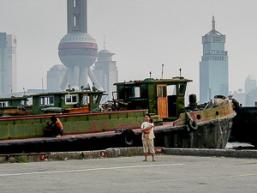
Tender Side of Life
Contrasting most sharply with these critical observations of a modern China that endlessly fascinates and repels were very personal experiences that illuminated another side of China that I either had missed before or that represents qualities that I hope are on the rise there. This is what I call the tender side to life in China. Tender is not a word I would have associated with China before this trip.
This tender side began to reveal itself on my 14-hour flight from Los Angeles to Shanghai on China Eastern Airlines. It was a packed flight with mostly Chinese travelers and a smattering of Westerners. The Los Angeles area has a very large Chinese contingent, a mix of mainlanders and Taiwanese who have families in China and many have strong economic ties as well. Sitting in coach, I expected a dreadfully long ride with few conveniences. But our young Chinese flight attendants were fast and efficient. A full three meals were offered, and the food was surprisingly good.
Near the end of the flight an exercise video came on with soft and soothing music. A young Chinese woman on the video informed us that after the long trip and the constant sitting we needed to exercise our bodies and stretch our limbs so we could invigorate ourselves and leave the plane with some semblance of alertness. My fellow Chinese passengers, young and old alike, jumped right into the exercise regime, and as I looked about I appreciated what was going on. Then I reached my hotel, a Days Inn that I was told was a four-star plus hotel, but with the name and logos I was anxious. Upon entering the lobby and making my way to the front desk, I realized that it was indeed a fine hotel. The staff I met the first night was alert and helpful. Since I was going to be at this hotel for eight nights, this struck me as a good sign.
The next morning, I realized that my Blackberry wasn’t working. I went to the concierge, a young man in his late 20s, and asked if there was a repair store in the vicinity. Within the hour he called my room to say that he found a store some distance away, and that he would be pleased to accompany me to help navigate. So he called a cab and off we went. Twenty minutes later we reached a small street somewhere in the heart of Xi’an. On the second floor of a drab two-story building, I could make out the word "Blackberry." We walked up the stairs only to find that the store wouldn’t open for two more hours. Cheerfully, he said that he could stay with me those two hours before we returned. We were near the Big Wild Goose Pagoda, one of Xian’s renowned cultural attractions, and we walked the two miles to the site, conversing as best we could in my non-existent Chinese and his limited English.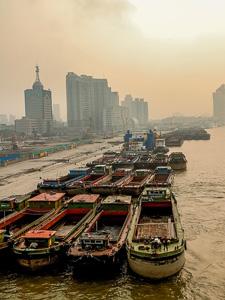
After visiting the pagoda, we returned to the Blackberry store where a young, tech-savvy employee checked my Blackberry and charger and determined that I had a faulty charger. As we returned to the hotel, I wondered to myself how many hotel staffers would extend me the courtesy I was shown. This young man spent virtually a half-day as my guide and technology savior. I couldn’t believe it.
During the rest of the day, the hotel staff made calls on my behalf, helping me to arrange meetings and other errands. In each and every case, they were cheerful, calm, efficient and knowledgeable.
Other tendernesses came my way. I had told a Chinese friend in Santa Barbara that on one of my days off from the conference, I wanted to go to Mount Huashan, located about 100 kilometers from Xi’an. Huashan is actually a group of five peaks known for their sheer faces and the hair-raising trails you take to ascend them. Through the inevitable chain of connections, a young couple and a driver picked me up promptly at 7 a.m., and we made our way toward the mountains.
On the climb to the eastern peak of Huashan, I was so impressed by how the driver and the young couple watched over me. The couple, in their late 20s, seemed so connected with each other, holding hands and talking to one another with great tenderness. Along the ancient path up to the top, hundreds of mostly young Chinese were cheerfully making their way up the mountain. Here and there along the way came solitary figures, grizzled and tough, the porters who have been carrying supplies to the mountain top monasteries since ancient times. On their backs today they carry bags of cement, stones, soft drinks, anything needed up on high. One of the porters, older than most of the others, sang what I was told was a very old folk song from this region. It was spellbinding. People respectfully moved out of his way and on one occasion a young fellow joined his song. When he did, I felt the soul of ancient China was singing to me.
On our way back to Xi’an the young couple took me to a Buddhist monastery fronted by a huge plaza where a giant statue of a reclining Buddha commanded the hardscape. It was sunset, and people were back from their daily jobs. Kids were running about, and on either side of the plaza two groups of women were dancing to recorded traditional Chinese music. They were mostly middle-aged, and all were graceful dancers who kept the rhythms and displayed beautiful hand gestures, dancing for almost an hour as I wandered about the monastery. The whole scene was one of calm serenity and playfulness.
Later, back in Beijing, accompanied by another young couple who, through other connections, met me at the airport to show me the city, I was struck again by the affection on display. It was not a smothering kind of young infatuation but very respectful, warm and sustained throughout the long day we spent together. As we walked through Beijing’s hip art district and later to Tiananmen Square and Behai Park, I saw young couples everywhere, holding hands, nuzzling up to each other in endearing ways. The human touch seems very much alive and well in modern China, even as the hardscape – its cities, its roads, its airports and harbors – is in a state of perpetual transformation and turmoil.
China in the Raw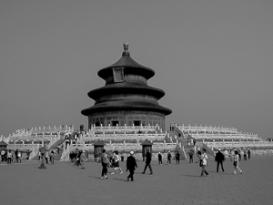
And as China in the raw lingers, so, too, does its tender side. The warmth and caring I experienced from the young adults who tended to me, the images of those women dancing, and the timeless beauty of the heritage sites I visited – the pagodas, and monasteries, the steady stream of visitors making their way up Mount Huashan – and the young sophisticates walking the galleries and creating their own marks in Beijing’s art district. Perhaps the raw China that is still on the make may find a way to slow down, take stock of things, discover ways to better tap the mighty talents and human qualities of its people so there might be less rawness and more tenderness ahead. That China, were it to come to pass, would give credence to the government’s claim that it aims to be creating a “peaceful and harmonious society.”
All photos are copyright protected and may not be used without permission. All photos are courtesy of Laura Settle.